For the brochure, please click here.
"With such a high diversity of herpetofaunal species now in Florida, it appears that the stage is now set for a species... to have devastating impacts." – Krysko et al. (2011)
"To leave such a situation unaddressed is like leaving a slow-burning fuse lit to an ecological bomb." – Engeman et al. (2011)

Credit: Dennis Giardina, Florida Fish and Wildlife Conservation Commission
Nonnative, exotic, or alien species are animals and plants living outside their native ranges as a result of human activity. Only a small portion of these species become invasive, but those that do can cause harm to ecology, economy, and human health. Invasive species are second only to habitat loss and fragmentation in contributing to loss of biodiversity worldwide.
Florida's populations of reptiles and amphibians are strikingly out of balance as a result of nonnative invasions. The state has more introduced species of reptiles and amphibians living and breeding in the wild than anywhere else in the world. There are many more species of nonnative lizards breeding in Florida than native lizards.
While the Burmese python has received wide public attention, at least 179 other species of reptiles and amphibians, like Nile monitors and Argentine black and white tegus, have passed relatively unnoticed into Florida's urban and natural landscapes. The potential impacts of the invasion extend beyond pythons and beyond the species already introduced.
This fact sheet summarizes findings from three recent scientific papers (Engeman et al, 2011; Krysko et al, 2011; Meshaka, 2011) describing who these invaders are, their potential ecological impacts, and recommendations for their management and control.
Florida: An Invasive Species Hotspot
Southern Florida offers a subtropical climate (Figure 2) and natural and manmade habitats similar to those found in the tropical regions from which many of the invaders originate. The island-like geography of Florida's southern peninsula and the fact that the region is isolated from areas of similar climate mean that there are relatively few native species to compete with the invaders, allowing them to thrive and spread.
Florida is also a central location for the exotic pet trade (Figure 3). The region contains major ports of entry into the United States and supports a thriving captive wildlife industry. Pets either escape or are released into the wild by pet owners or breeding facilities. Occasional destructive hurricanes increase the risk of escapes.
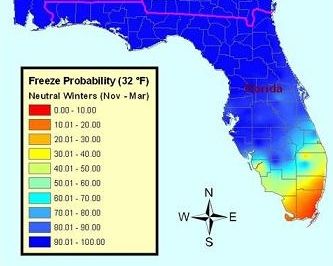
Credit: National Weather Service

Credit: Krysko et al. (2016)
Who Are the Invaders?
As of 2015, scientists have identified at least 63 established (i.e., breeding) species of nonnative reptiles and amphibians in Florida. This includes approximately 48 species of lizards, 4 frogs, 5 turtles, 5 snakes, and 1 crocodilian (Krysto et al. 2016). The numbers are imprecise because we still lack information about whether some species are breeding year after year.
The Profile of Florida's Exotic Reptiles and Amphibians Is Changing
Old Invaders (e.g., Figures 4–7)
- Small-bodied lizards and frogs
- Early-maturing
- Insectivores
- Strongly associated with people and disturbed habitat
- Most introduced through cargo
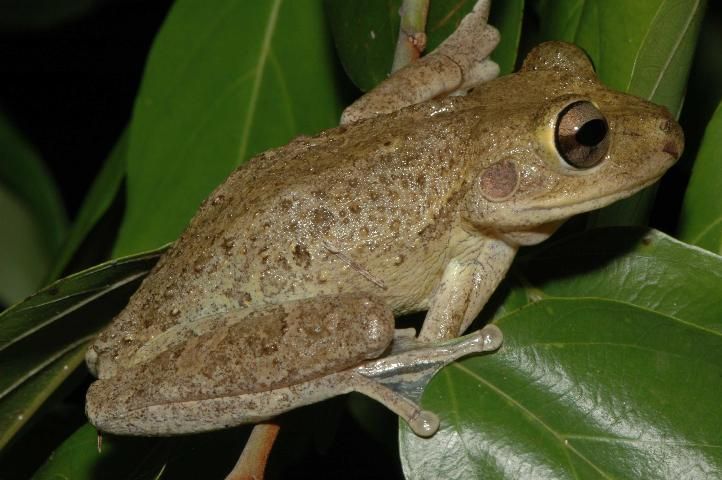
Credit: University of Florida
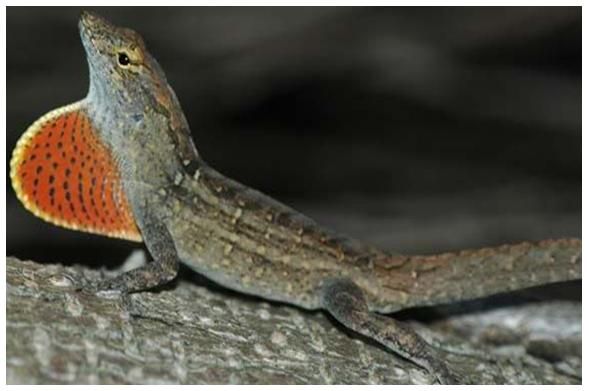
Credit: Ianaré Sévi
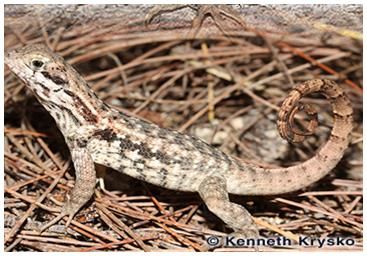
Credit: Kenneth Krysko
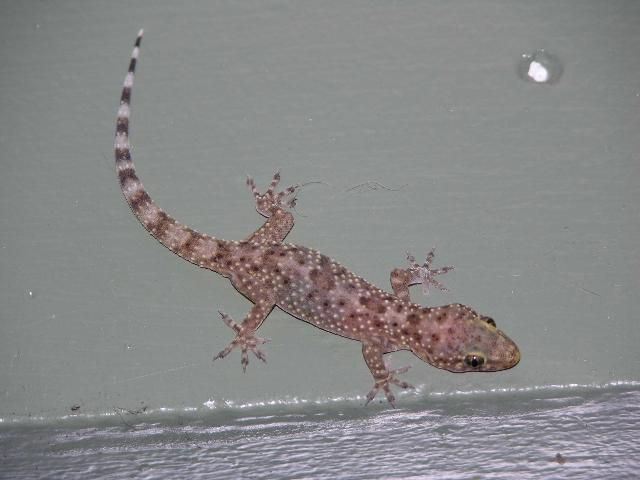
Credit: Steve A. Johnson, University of Florida
New Invaders (e.g., Figures 8–11)
- Large-bodied lizards and snakes
- Relatively early-maturing and prolific breeders
- Predators of vertebrate prey
- Thrive in a wide range of habitats
- Most introduced through the pet trade
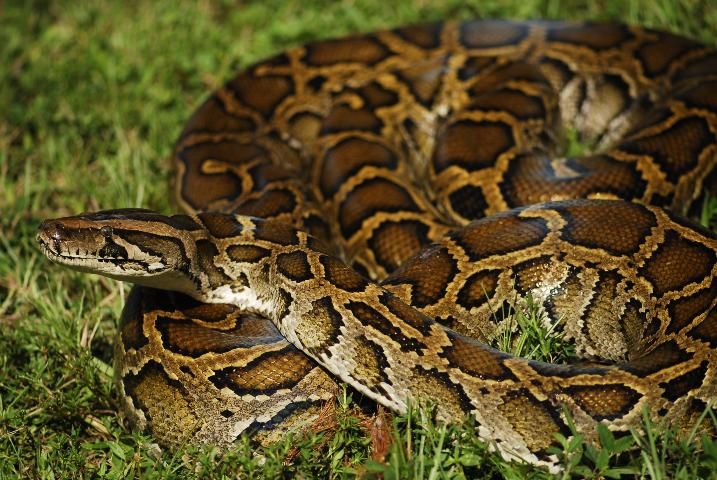
Credit: University of Florida
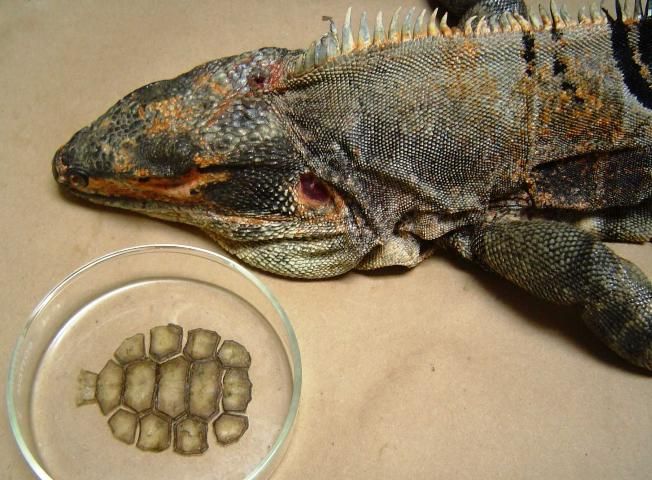
Credit: Eric A. Tillman, USDA Wildlife Services
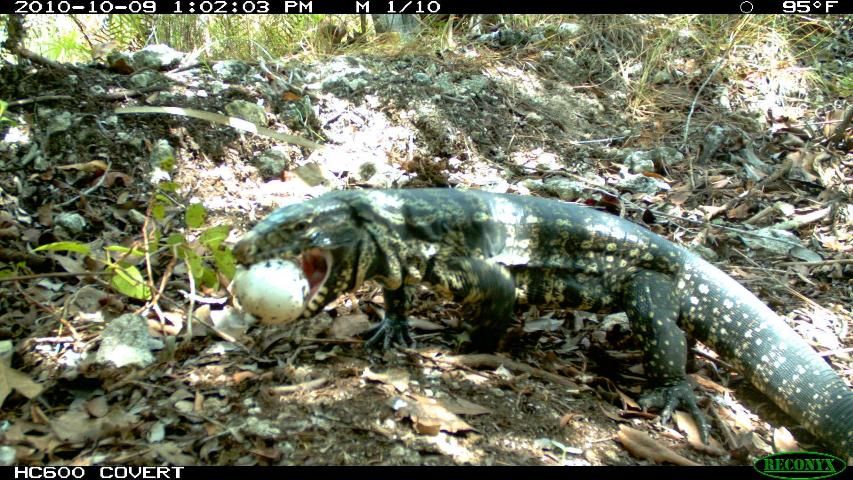
Credit: Tony Pernas, National Park Service

Credit: Bill Bayless, used with permission
What Are Their Impacts?
It is impossible to predict with certainty which invasive species might cause adverse impacts to native ecosystems. Few of the 50+ established reptile and amphibian species have been studied sufficiently to determine their impacts. But scientists agree they can cause harm through predation on native species, competition with native species for limited resources, and spread of disease. Some species also affect Florida's economy and our quality of life. Unfortunately, when it becomes obvious that damage is occurring, it is most often too late to take action to reduce negative impacts.
The Cuban treefrog and the Burmese python are examples of invasive species with known or potential impacts and for which it is too late for eradication.
We now have scientific evidence that the presence of Cuban treefrogs is linked (through predation and competition) to decreased populations of native green treefrogs and squirrel treefrogs (Figure 12). However, the species is now so widespread and abundant in urban and natural areas throughout much of Florida that its management is a serious challenge.

Credit: Photo: Nancy Bennett
Burmese pythons are generalist predators that eat a variety of prey (Figures 13-14) including endangered species. Recent growth of the Everglades python population has coincided with severe declines in mammal populations, but further research is needed to determine if pythons are truly the cause. If they are not, then these findings may point to other problems in the Everglades ecosystem.
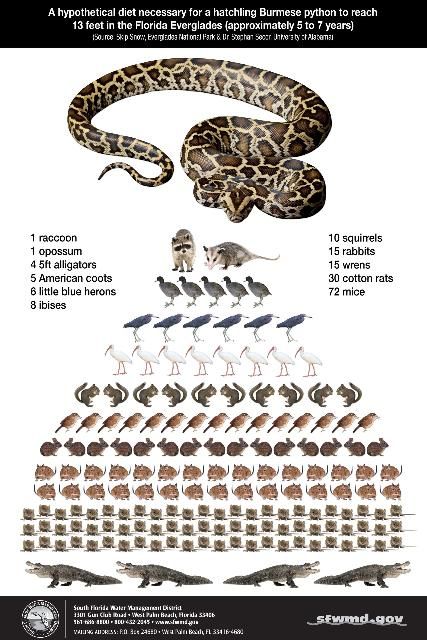
Credit: SFWMD, Skip Snow, Everglades National Park; and Dr. Stephan Secor, University of Alabama.
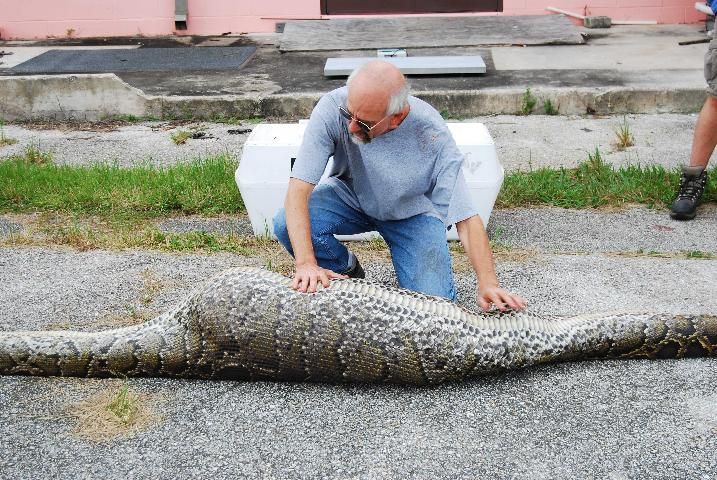
Credit: Everglades National Park
How Can We Slow the Runaway Train?
Meshaka (2011) characterized the problem of exotic reptiles and amphibians in Florida as a "runaway train in the making." Prevention of their introduction into the environment is the only guaranteed effective approach to reduce impacts of invasive species. But for many species the time for prevention is past. To control those that are already established and to prevent further introductions, we need to find sustainable funding for a comprehensive statewide plan that includes the following elements:
- Screening and Risk Assessment
Effective prevention will require new restrictions on the pet trade of imported reptiles and amphibians based on standardized and validated risk assessment protocols for individual species.
2. Early Detection and Rapid Response (EDRR)
Coordinated EDRR efforts are essential to prevent more of the 179 introduced species from establishing breeding populations. Research-based response efforts must include examination of species' life histories, potential impacts, and vulnerabilities, and development of innovative removal strategies.
3. Control and Containment
For species already established and past eradication, we need to develop practical control methods and integrated management strategies to contain the current population in the invaded area and minimize impacts to valuable natural resources such as wading bird colonies and listed species.
4. Outreach and Education
Engaging the public is critical to prevention and EDRR efforts, both by fostering responsible pet ownership and enlisting citizens to help detect and report nonnative invaders. Outreach to decision makers and resource managers will ensure continued support for the statewide comprehensive plan.
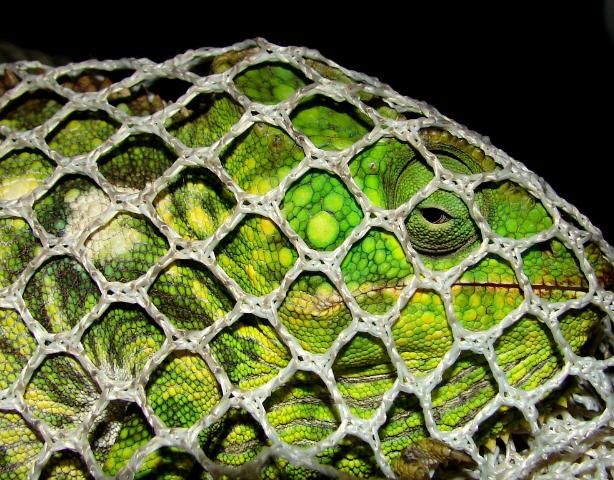
Credit: Dennis Giardina, Florida Fish and Wildlife Conservation Commission
References
Dorcas, M.E., J.D. Willson, R.N. Reed, R.W. Snow, M.R. Rochford, M.A. Miller, W.E. Meshaka, Jr., P.T. Andreadis, F.J. Mazzotti, C.M. Romagosa, and K.M. Hart. 2012. Severe mammal declines coincide with proliferation of invasive Burmese pythons in Everglades National Park. Proceedings of the National Academy of Sciences 109(7):2418–2422.
Engeman, R., E. Jacobson, M.L. Avery, and W.E. Meshaka, Jr. 2011. The aggressive invasion of exotic reptiles in Florida with a focus on prominent species: A review. Current Zoology 57(5):599-612.
Krysko, K.L., L.A. Somma, D.C. Smith, C.R. Gillette, D. Cueva, J.A. Wasilewski, K.M. Enge, S.A. Johnson, T.S. Campbell, J.R. Edwards, M.R. Rochford, R. Tompkins, J.L. Fobb, S. Mullin, C.J. Lechowicz, D. Hazelton, and A. Warren. 2016. New Verified Non-indigenous Amphibians and Reptiles in Florida Through 2015, With a Summary of Over 152 Years of Introduction. IRCF Reptiles & Amphibians 23:11-143.
Krysko, K.L., J.P. Burgess, M.R. Rochford, C.R. Gillette, D. Cueva, K.M. Enge, L.A. Somma, J.L. Stabile, D.C. Smith, J.A. Wasilewski, G.N. Kieckhefer III, M.C. Granatosky, and S.V. Nielsen. 2011. Verified non-indigenous amphibians and reptiles in Florida from 1863 through 2010: Outlining the invasion process and identifying invasion pathways and stages. Zootaxa 3028:1–64.
Meshaka, W.E., Jr. 2011. A Runaway Train in the Making: The Exotic Amphibians, Reptiles, Turtles, and Crocodilians of Florida. Monograph 1. Herpetological Conservation and Biology 6:1–101.
Waddle, J.H., R.M. Dorazio, S.C. Walls, K.G. Rice, J. Beauchamp, M.J. Schuman, and F.J. Mazzotti. 2010. A new parameterization for estimating co-occurrence of interacting species. Ecological Applications 20(5):1467–1475.
Working Group and Science Coordination Group of the South Florida Ecosystem Restoration Task Force. 2010. Invasive Exotic Animals: Managing a Threat to Everglades Restoration. Information Brief Series, http://www.sfrestore.org.